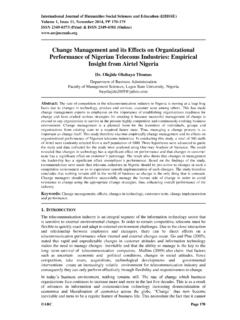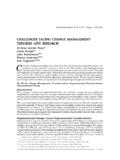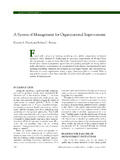Transcription of Diversity and Organizational Change - bogda.com
1 The 1998 Annual: Volume 2 Consulting, Jossy-Bass/Pfeiffer, 1998. Diversity and Organizational Change By Ginger Lapid-Bogda, Abstract: Diversity is often viewed as a training program, limited to a human resources initiative focused on race and gender and separate from Organizational Change efforts. However, as the article describes, the definition of Diversity is much broader, encompassing primary, secondary, and tertiary dimensions that go beyond race and gender. The aim of Diversity is to allow all individuals to contribute fully to the success of the organization. Thus, integrating Diversity and Organizational Change efforts can enhance the success of most types of Organizational Change . Organization development theory and principles can also add significantly to the outcomes of Diversity initiatives through the effective use of contracts, assessments, action research methodology, and other critical components. In the current competitive world, Diversity and organization development must be partners in successful Organizational Change efforts.
2 Many consultants (as well as most managers) view Diversity as an initiative of human resources, separate from Organizational Change efforts. This dichotomous thinking negatively impacts the effectiveness of any Organizational Change , such as quality, Organizational redesign, team building, or coaching. Where does this polarized thinking come from? Misunderstanding Diversity as an issue of race and gender, a repackaging of affirmative action in 1990s clothing, leads to this narrow view. From this perspective, Diversity means raising the organization's number of white women as well as men and women from a variety of ethnic/racial backgrounds. It may also mean adding a few differently-abled people in "behind the scenes" jobs. This limited definition of Diversity ignites political dynamite on two fronts: White men see reverse discrimination Many men and women of color, as well as white women, live with the Organizational perception that they came into the organization (or other institutions) under the affirmative action umbrella, not as a result of their own merit A DEFINITION OF Diversity .
3 Diversity , however, breaks the affirmative action framework and goes beyond race and gender (Thomas, 1990). In fact, the new Diversity paradigm defines it as the process of creating and maintaining an environment that naturally enables all participants to contribute to their full potential in the pursuit of organization objectives (Thomas, 1993). The following model can be helpful to more fully understand what it means to enable all persons to contribute their full potential to their organizations. Primary Dimensions The inner circle shows the primary dimensions of Diversity -- those that are fundamental to a persons' self-concept or core self. These dimensions, though not necessarily visible, are unchangeable in that they are not a matter of choice. They form the basis on which people make instantaneous judgments about one another, often through the process of stereotyping. Secondary Dimensions The middle circle consists of secondary dimensions of Diversity . These are aspects of a persons' identity that are important to a definition of self, but are not as fundamental as the primary dimensions.
4 2004 Ginger Lapid-Bogda, (310) 829-3309 The 1998 Annual: Volume 2 Consulting, Jossy-Bass/Pfeiffer, 1998. Functional Level/. Classification Geographic Location location Seniority Work Appearance Experience Race Age Marital Work Parental Caste/ Division/. Status Status Ethnicity Class Content/ Field Group Religion Physical Gender Income Ability Sexual Orientation Recreational Personal Habits Habits Educational Background Management Status Tertiary Dimensions In addition, it would be possible to add a third circle that consists of the tertiary dimensions of Diversity , such as learning style, personality, and professional orientation. All three categories (primary, secondary, and tertiary) contribute to the formation of a person's unique life experiences, perspectives, and skill sets. An effective organization can learn to recognize, understand, appreciate, respect, and utilize these multiple aspects of a person in the pursuit of its mission and objectives. This broadened definition of Diversity sheds light on another reason for misunderstanding the connections between Diversity and Organizational Change .
5 Diversity is often perceived as a program, not a significant and complex Organizational Change process. Defined in this way, Diversity frequently is dealt with as a training program for employees (usually managers only). Training programs by themselves, however, rarely have the muscle to Change the organization's culture. A Diversity effort that focuses primarily on training is, therefore, not likely to achieve long-term or long-lasting results. 2004 Ginger Lapid-Bogda, (310) 829-3309 The 1998 Annual: Volume 2 Consulting, Jossy-Bass/Pfeiffer, 1998. THE CONTRIBUTION OF Diversity TO Organizational Change . Integrating Diversity and Organizational Change efforts can enhance the success of most types of Organizational Change . All major Organizational Change involves a cultural Change , and a Diversity effort is cultural Change at its core. It requires an organization to search its collective soul and focus on essential aspects of its culture: seminal values; Organizational demands for conformity in thought, interpersonal style, and action; power structure and power dynamics; employee participation; and inclusion/exclusion issues, to name a few.
6 Cultural Differences In addition, most Organizational changes involve Diversity components. An Organizational redesign, for example, may combine functions that have previously been separate, such as marketing and manufacturing. Certainly, marketing and manufacturing have two distinct "cultures" and a successful redesign needs to pay attention to those cultural issues involved. Diversity offers both the perspective and the technology to deal with these intercultural issues, whether they are triggered by redesigns, mergers, or global expansions. When an organization is redesigned, some of its subsystems discover they have to transact a new form of "business" with new, unfamiliar "partners." Naturally, they assume that their established styles of doing business, their traditional practices, priorities, values, and methods, will be perfectly acceptable, perfectly functional. Thus, marketing is surprised when this assumption turns out to be invalid for manufacturing. Marketing assumes that its new partner, manufacturing, simply has not appreciated the benefits of changing and adapting to marketing's traditional way of doing business.
7 Thus, Organizational redesign invariably leads to Organizational conflict. A Diversity perspective adds insight to the identification of and techniques for the management of such issues. Conflict, by definition, means that differences exist. These differences may be based on style, role, values, priorities, power, mental models and patterns of thinking, or culture. The Diversity perspective of valuing and utilizing differences offers a positive framework from which to manage conflict. Team Effectiveness Team effectiveness has even clearer Diversity connections. For a team to develop and be effective, its members must find productive ways to both elicit and manage individual and subgroup differences. In any group development model, there is always some version of a "storming" stage fairly early in a group's development. The group must navigate this troublesome phase successfully to evolve toward more productive phases of development. Successful navigation cannot occur if differences are submerged or conformity is forced upon diverse members.
8 To be effective means to acknowledge differences and to utilize them creatively to gain the team's objectives. Organizational Cultural Shift In the case of a complex organization Change (for example, going from a production-driven to a marketing-driven focus or moving toward Total Quality), a fundamental shift in Organizational culture must occur. A cultural Change of this magnitude and complexity poses a major challenge for most organizations because of the ambiguity involved and the enormity of the task. An understanding of Diversity enables organizations to find ways not to insist on conformity in a major Change process, but to encourage employees to contribute, to take a fresh look, and to continuously evolve. 2004 Ginger Lapid-Bogda, (310) 829-3309 The 1998 Annual: Volume 2 Consulting, Jossy-Bass/Pfeiffer, 1998. THE CONTRIBUTION OF ORGANIZATION DEVELOPMENT TO Diversity . A Clear Contract From the opposite perspective, the question is how Organizational Change theory and organization development strategies and methods can assist in Diversity Change efforts.
9 Unfortunately, many organizations -- as well as many Diversity consultants -- view Diversity as a human resource issue. In relegating Diversity to this HRD context, they charter the HR department to roll out Diversity programs without utilizing effective Change technology. For example, OD's action research method illuminates the steps that must be taken for effective Change to occur. There must be a contract for the Diversity effort that defines the goals, roles, expectations, resources, and scope of the intended Change . Many Diversity initiatives violate this principle by starting with a focus that is too narrow to be effective ( , mentoring program only) or too broad to accomplish and too vague to measure (" Change the work environment"). Other Diversity Change efforts begin without serious consideration of the required resources. Are the organization's leaders truly committed to the effort? Do they have proficiency in the skill-sets they need to support the implementation of this effort?
10 Do they have the authority to spend the time and money necessary for what they are trying to achieve? Contracting helps resolve the above issues at the front end. Needs Assessment A systemic Organizational assessment is just as essential to a successful Diversity effort as to any Organizational Change initiative. Without an assessment, how can an organization know what issues exist and what their various underlying root causes might be? The organization's decision makers cannot know where to put their time and resources. Perhaps a training program is needed but what type, by what time, and for whom? On the other hand, training may not be the most effective approach. For example, holding senior managers accountable for achieving Diversity goals, as well as for changing Organizational practices, may result in more Diversity success, in less time, and at a lower cost than a program. Also, it will be difficult for the organization to know whether Diversity related progress has been made over time unless there is a baseline against which to compare the Change .






